|
June 1948 Popular Science
 [Table of Contents] [Table of Contents]
Wax nostalgic about and learn from the history of early
electronics. See articles from
Popular
Science, published 1872-2021. All copyrights hereby acknowledged.
|
Evidently I am in good
company with my appreciation for good humor related to science and technology.
This "Cartoons Teach Physics with a Smile" article appearing in the June 1948
issue of Popular Science magazine cites the College of the City of New
York's Professor Robert S. Shaw's use of such hilarity in his physics classes.
Whereas the artists who created these comics probably did not intend to
illustrate a particular physics principle, many people familiar with the
principles are quick to recognize what is going on. As can be seen in the
hundreds of electronics and technically themed comics on the pages linked at the
bottom of the page, those which showed up in publications like Radio and
Television News, Short Wave Craft, Radio-Electronics,
QST, and Popular Electronics were specifically created for the
type audience that reads them. BTW, I learned a new word here:
isostasy. An unrelated
story that occupied the other half of one of the pages reports on a problem
telephone cable stringers had with gophers chewing through the insulation -
definitely not funny at the time to the engineers, but kind of funny in
retrospect. I added the color.
Cartoons Teach Physics with a Smile
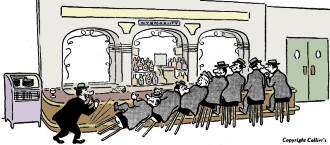
Propagation of a wave is illustrated by Prof. Shaw, for students
of mechanics and hydrodynamics, with this humorous analogy from his cartoon collection.
Artist Colin Allen's original caption had the prankster saying, "I've always wanted
to try this" - a commendable predilection, if indulged under more appropriate circumstances,
for the experimental method. Copyright Collier's
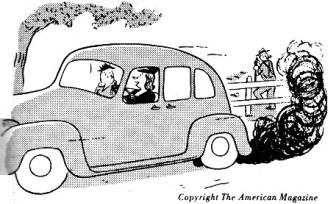
"I always keep the emergency brake on just in case of emergency." Copyright The American Magazine
Friction converts mechanical energy into heat - as lady motorist,
whose concern for safe driving exceeds her comprehension of machinery, unwittingly
demonstrates in Stan Hunt cartoon.
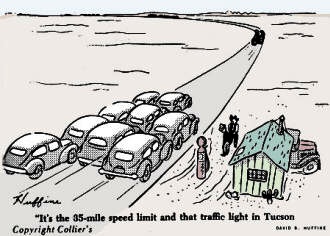
"It's the 35-mile speed limit and that traffic light in Tucson." Copyright Collier's
Radar's klystron tube uses principle vividly illustrated by this cartoon. Cars
traveling in clusters correspond to speeding electrons, similarly grouped or "bunched"
in vacuum tube.
A collection of more than 1,100 cartoons, clipped from newspapers and magazines
over a period of years, enables Prof. Robert S. Shaw of the College of the City
of New York to enliven his physics classes with apt and amusing illustrations. Often,
his students find, a humorous analogy offers welcome aid to grasping a point in
mechanics, optics, acoustics, or electronics.
Lantern slides made from his favorite cartoons conclude class periods. For reference,
others are grouped by the points they illustrate in scrapbooks, covering with remarkable
completeness such subjects as "Statics," "Heat and Sound," and "Molecular and Atomic
Physics." Five examples are reproduced here, through the courtesy and by special
permission of the copyright owners.
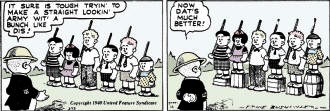
The theory of isostasy, dealing with the tendency of equally
massive blocks of the earth's crust to seek a common level, gets an assist with
this clipping from the newspaper "funnies."
Cartoonist Ernie Bushmiller might be astonished to find his popular comic strip
"Nancy" serving at the College of the City of New York to point up an abstruse principle
in geology.
Copyright United Features Syndicate
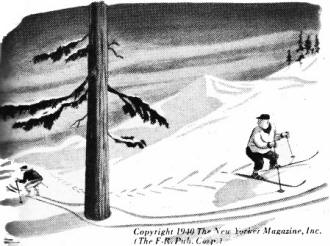
But for the forces between the remote atoms of matter, one solid
object could readily pass through another, and the fantasy of Charles Addams' captionless
drawing could be fact. Copyright 1940 The New Yorker Magazine, Inc. (The F-R. Pub Corp.)
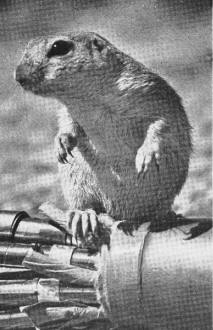
Cable-Eating Gophers Foiled at Last
To the gopher perched on this cutaway section, an A. T. & T. coaxial cable is
an appetizing meal-even though it is buried six feet deep and has an exterior
sheath of lead, phenolic and jute wrapping, and steel and copper tape covering
the conductors.
Almost as soon as brand-new cables for transcontinental phone calls were laid
west of the Mississippi, where gopher land begins, the burrowing rodents began
disrupting service with short circuits and crossed lines. They gnawed right
through all the layers.
Experimenters then offered captive gophers a diet of cable sections packed in
earth-filled cans. Inner wrappings of .005-inch and .007-inch copper tape failed
to stop them. Finally, .010-inch copper tape proved too much for all but one
extra-sharp-toothed gopher. The scientists settled for that, and today this tape
stops all but the most determined gophers from cutting in on your call.
These Technically-Themed Comics Appeared in Vintage Electronics Magazines.
I personally scanned and posted every one from copies I own (and even colorized
some). 235 pages as of 6/28/2024
|
|
|
|
Posted February 16, 2024
|